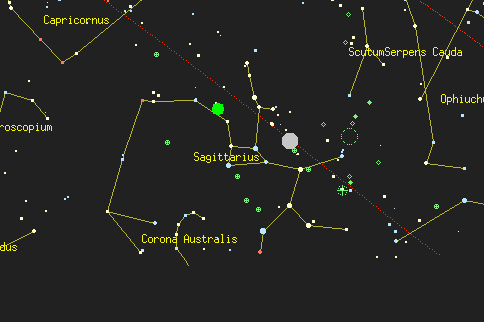Sagittarius:
The Archer, the Eagle, and the Ship
by Peter Krüger
©2011

| Völuspá CR 48/ H 42: Hrymr ekr austan, hefisk lind fyrir, snýsk Jörmungandr í jötunmóði. Ormr knýr unnir, en ari hlakkar, slítr nái Niðfölr, Naglfar losnar. |
Hrym drives from the east, his shield before him. the mighty serpent writhes in gigantic fury. The snake thrashes the waves and the eagle grows joyful, pale-beak plucks corpses, Nail-Ship breaks its moorings. |
Hrymr: the constellation Sagittarius with his bow. The bow interpreted here as a shield (Of interest, there is also a modern constellation called the shield next to it, which I don't know the origin of it.)
"from the east": this simply refers to the rising of the constellation Sagittarius at the eastern horizon.
The Eagle: directly above Sagittarius we find Aquila, the eagle, still
in the modern sky.
Naglfar: directly below Sagittarius we find in the cuneiform
tablet MUL.APIN a ship/bark called MA.GUR8.
Therfore we find a group of constellations depicting a man with a shield
(bow), the eagle and the boat directly next to each other in the sky!
Why Jörmungandr is mentioned in this connection is not completely clear to
me. I identify Jörmungand with the constellation Hydra, the water snake,
that is already setting in the west at the time Sagittarius is rising in
the east. Maybe a meaning of the kind: when Sagittarius rises in the
east than Hydra is setting in the west.

After having interpreted Hrymr as the constellation Sagittarius and
Naglfar as the ship/bark called MA.GUR8 in sumerian cuneiform it's getting even
more exciting to look on the following stanza of Voluspa 51:
There is mentioned a Kjoll = keel of a ship, coming (=rising) in the east. There
is also a Greek/Roman constellation called = "the keel of the ship" in the sky,
the constellation Carina. It's part of the constellation Argo Navis, called "the
great ship". A part of it was called Pedalion, the rudder. The chief pilot of
the ship is the second brightest star of the sky (Canopus), and as you know Loki
is often brought into connection with the brightest star of the sky, Sirius. So
maybe both the brightest and the second brightest star of the night sky might
refer to Loki (well, one more proof of his name having a connection with leukós
= the bright one).
The location of Argo Navis is by the way directly below Lupus,
the wolf.
What makes this identification very mysterious is the fact that Argo
Navis is only visible till 37 ° North, i.e. in Germany, Norway or Island
it's not rising and is not visible, the same for Lupus. This might proof
the age of this stanza, it can't be the invention of a middle European
or somebody from Island, only of people living more south (or of course
of seafarers travelling to the south).
